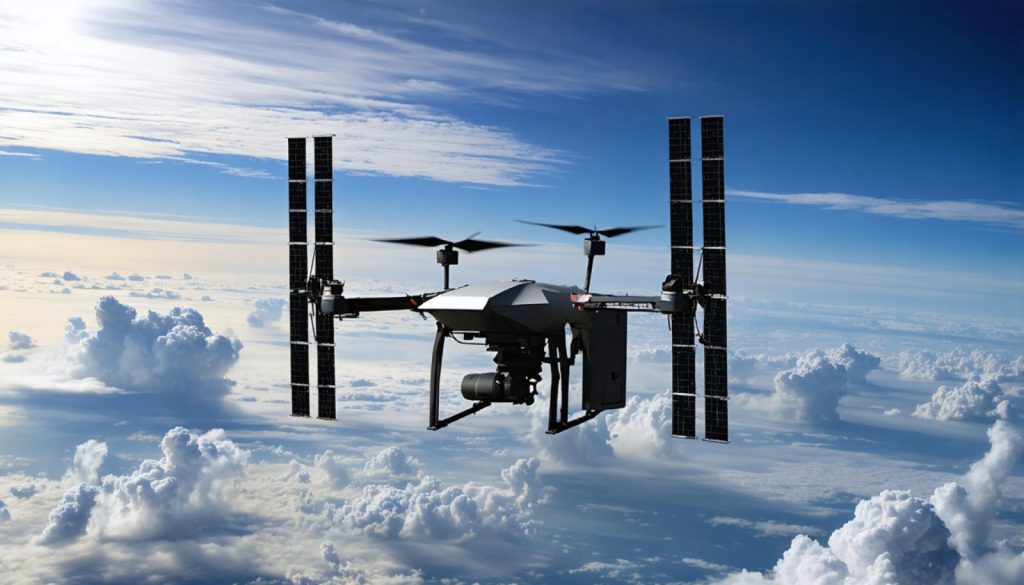
- Satellites play a crucial role in disaster relief by providing real-time, precise data that aid in forecasting and preparedness.
- High-resolution satellite imagery assists in post-disaster analysis, helping relief efforts by identifying safe routes and damaged infrastructure.
- Satellite communications maintain connectivity in disaster zones, ensuring communication when traditional networks fail.
- Global organizations leverage satellite data for comprehensive disaster risk assessments and response strategies.
- As climate change increases the frequency of natural disasters, satellite technology’s ability to empower and connect communities becomes essential.
- Satellites enhance the global capacity to respond swiftly and effectively to crises, reinforcing resilience and unity.
Amid the chaos of natural disasters, a silent hero orbits above, reshaping how the world responds to these crises. Satellites, those high-tech sentinels in the sky, are revolutionizing disaster relief with invisible threads of technology. This evolution is not just about progress; it’s a life-saving intervention.
From Eye in the Sky to Ground Actions
Picture this: a hurricane barrels toward a populated coast, its destructive energy spreading fear. Before it reaches land, however, satellite technology has already scanned the growing storm. Precision sensors aboard orbiting spacecraft gather data and deliver real-time forecasts that are chillingly accurate. Governments and agencies worldwide brace for impact with evacuation plans and timely warnings, their strategies shaped by data from 22,000 miles above Earth.
Mapping Chaos into Clarity
Once the tempest passes, satellite imagery paints a vivid aftermath canvas, turning confusion into clarity. High-resolution photos slice through the initial chaos, unveiling which roads remain passable and which buildings stand intact. Relief organizations use these insights to strategically deploy resources where they’re needed most. This efficiency not only speeds up aid delivery but often saves lives that hang in the balance.
The Power of Connectivity
In disaster-struck zones, communication can be a lifeline. Satellite communications ensure that even the remotest corners stay connected when terrestrial networks fail. Aid workers, equipped with satellite phones and broadband terminals, communicate swiftly with command centers, coordinating cross-continental efforts with ease.
It’s not just a matter of restoring services; it’s about rebuilding trust and safety in communities desperately in need. Imagine a village, isolated by floodwaters—satellite tech bridges the gap, making the unreachable reachable once again.
A Global Network of Watchful Eyes
Organizations like the United Nations and NASA rely heavily on satellite data to predict and assess disaster-specific phenomena. The Copernicus Emergency Management Service and GOES (Geostationary Operational Environmental Satellites) provide invaluable tools for monitoring and mitigating global disasters. These satellite systems are indispensable for creating comprehensive risk assessments, ensuring communities are not only reactive but prepared long before disasters strike.
Takeaway: Empowerment from Above
Satellite technology, with its profound ability to observe, analyze, and connect, ensures no place on Earth remains isolated in its hour of need. As climate change intensifies, the role of these celestial monitors becomes impossibly vital. This unseen presence overhead isn’t just technology; it’s an empowering force, enabling humanity to react swiftly, decisively, and compassionately.
In a world where disasters can no longer be avoided, satellite technology serves as a beacon of hope and efficiency, reinforcing the resilience of societies and underscoring the strength of global unity in times of crisis.
How Satellites Are Revolutionizing Disaster Relief: The Unseen Heroes Above
Transformative Impact of Satellite Technology in Disaster Relief
In an age where natural disasters are becoming increasingly frequent and severe due to climate change, satellites offer an extraordinary capability to transform emergency responses worldwide. Rather than reacting post-disaster, modern satellite technology provides the foresight and connectivity essential for pre-emptive action and comprehensive recovery.
Real-World Use Cases: Satellite Technology in Action
1. Early Warning Systems
– Satellites like NASA’s GOES provide critical early warnings for hurricanes, tornadoes, and floods. This allows for timely evacuations and preparations, potentially saving countless lives.
– The Indian Tsunami Early Warning Centre relies on satellite data for tsunami prediction and alerts, demonstrating the invaluable life-saving potential of this technology.
2. Impact Assessment and Resource Allocation
– Satellites swiftly map out damage post-disaster, helping disaster relief organizations like the Red Cross and FEMA (Federal Emergency Management Agency) to deploy resources effectively.
– The Copernicus Emergency Management Service uses satellite imagery to delineate flooded areas, enabling accurate resource delivery and infrastructure rebuilding plans.
3. Restoring Communication
– Companies such as SpaceX, with its Starlink satellite constellation, have been pivotal in restoring internet connectivity in disaster-stricken areas where terrestrial networks are disabled.
– In the aftermath of Hurricane Maria, satellite phones and broadband terminals were vital for establishing communication in Puerto Rico, expediting the coordination of rescue efforts.
Market Forecast and Industry Trends
– The satellite technology market is expected to continue growing robustly, with a projected compound annual growth rate (CAGR) of over 5% from 2023 to 2030 (Source: Business Research Company).
– Advances in AI and machine learning will enhance predictive capabilities, offering even more precise modeling and analysis before, during, and after disasters.
Pros and Cons Overview
Pros:
– Rapid Response: Provides instantaneous data and imagery for swift assessment and response.
– Global Coverage: Ensures coverage even in the remotest areas, bridging communication gaps.
– Predictive Analytics: Uses AI to enhance predictive modeling, refining accuracy in forecasting and impact analysis.
Cons:
– Cost: Deployment and maintenance of satellite infrastructure can be expensive.
– Data Overwhelm: The sheer volume of data can be challenging to process without sophisticated tools.
Security and Sustainability
– Satellite operators are increasingly prioritizing sustainability, focusing on reducing space debris and maximizing the lifespan of satellite missions.
– Security protocols are continually advanced to protect sensitive data from cyber threats, ensuring reliability in times of need.
Actionable Tips for Disaster Preparedness
1. Embrace Satellite-Based Solutions: Communities should invest in satellite communication tools for resilient connectivity during disasters.
2. Leverage Early Warning Data: Regularly update and test evacuation and response plans using the latest satellite data insights.
3. Foster Partnerships: Encourage collaborations between local governments, NGOs, and satellite data providers for improved readiness and resource sharing.
Conclusion: Harnessing the Power of Satellites
By embedding satellite technology into global and local disaster planning frameworks, societies can enhance their resilience and response capabilities exponentially. As climate-related disasters become more frequent, the role of satellites will evolve from merely supporting to fundamentally shaping the future humanitarian efforts. This hidden network is not just a marvel of modern technology, but a critical safety net for a rapidly changing world, demonstrating the strength of collaborative global unity in times of crisis.
For more information on satellite technologies and their global impact, visit the NASA and Copernicus websites.



